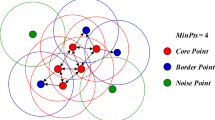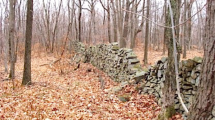Abstract
This article presents a new off-line method for the detection, analysis and estimation of an unknown cartographic projection and its parameters from a map. Several invariants are used to construct the objective function ϕ that describes the relationship between the 0D, 1D, and 2D entities on the analyzed and reference maps. It is minimized using the Nelder-Mead downhill simplex algorithm. A simplified and computationally cheaper version of the objective function ϕ involving only 0D elements is also presented. The following parameters are estimated: a map projection type, a map projection aspect given by the meta pole K coordinates [φ k , λ k ], a true parallel latitude φ 0, central meridian longitude λ 0, a map scale, and a map rotation. Before the analysis, incorrectly drawn elements on the map can be detected and removed using the IRLS. Also introduced is a new method for computing the L 2 distance between the turning functions Θ1, Θ2 of the corresponding faces using dynamic programming. Our approach may be used to improve early map georeferencing; it can also be utilized in studies of national cartographic heritage or land use applications. The results are presented both for the real cartographic data, representing early maps from the David Rumsay Map Collection, and for the synthetic tests.













Similar content being viewed by others
References
Arkin EM, Chew LP, Huttenlocher DP, Kedem K, Mitchell JSB (1991) An efficiently computable metric for comparing polygonal shapes. IEEE J PAMI 13(3):209–216
Bai X, Yang X, Latecki LJ, Liu W, Tu Z (2010) Learning context-sensitive shape similarity by graph transduction. IEEE J PAMI 32(5):861–874
Balletti C, Guerra F, Monti C (2000) Venice: new life in an old map: geometrical analysis and georeferenced visualisation of historic maps. Geoinformatica 3:40–43
Bertram M, Wendrock H (1996) Characterization of planar local arrangement by means of the delaunay neighbourhood. J Microsc 181(1):45–53. doi:10.1046/j.1365-2818.1996.93374.x
Buchar (2009) Assessment of the map projections for world maps. 18th International Cartographic Conference, Olomouc
Bugayevskiy LM, Snyder J (1995) Map projections: a reference manual. CRC Press
Burger G, Embury J, Wilkinson D (1990) The characterization of microstructures using tessellations and their application to deformation processes. Simul Theory Evolving Microstruct 199–209
Chang SH, Cheng FH, Hsu WH, Wu GZ (1997) Fast algorithm for point pattern matching: invariant to translations, rotations and scale changes. Pattern Recogn 30(2):311–320
Craciunescu V, Constantinescu S (2006) Eharta. http://earth.unibuc.ro/articole/eHarta?lang=en
Erle S, Krishnan S, Waters T (2009) World map warp. http://warp.worldmap.harvard.edu/
Esri (2003) Identify an unknown projected coordinate system using arcmap
Esri (2005) Identify an unknown projected coordinate system using arcmap
Fischler MA, Bolles RC (1981) Random sample consensus: a paradigm for model fitting with applications to image analysis and automated cartography. Commun ACM 24(6):381–395. doi:10.1145/358669.358692
Flacke W, Kraus B, Warcup C (2005) Working with projections and datum transformations in ArcGIS: theory and practical examples. Points Verlag. http://books.google.cz/books?id=PfEsAQAAMAAJ
Frank R, Ester M (2006) A quantitative similarity measure for maps. In: Riedl A, Kainz W, Elmes GA (eds) Progress in spatial data handling. Springer, Berlin Heidelberg, pp 435–450
Gao F, Han L (2012) Implementing the nelder-mead simplex algorithm with adaptive parameters. Comput Optim Appl 51(1):259–277. doi:10.1007/s10589-010-9329-3
Geography, Division M, Hébert J (1974) Panoramic maps of Anglo-American cities: a checklist of maps in the collections of the Library of Congress, Geography and Map Division, Library of Congress. http://books.google.cz/books?id=eZ7oGwAACAAJ
Gkalp E, Gngr O, Boz Y (2008) Evaluation of different outlier detection methods for gps networks. Sensors Peterboroug 8(11):7344–7358. http://www.mdpi.com/1424-8220/8/11/7344/
Hekimoglu S, Berber M (2003) Effectiveness of robust methods in heterogeneous linear models. J Geodesy 76(11-12): 706–713. doi:10.1007/s00190-002-0289-y
Huang JF, Lai SH, Cheng CM (2007) Robust fundamental matrix estimation with accurate outlier detection. J Inf Sci Eng 23(4):1213–1225
Huber P (1981) Robust Statistics. Wiley series in probability and mathematical statistics. Probability and mathematical statistics. Wiley. http://books.google.cz/books?id=HQp2BKN-qWoC
Itoh R, Horizoe M, Gotoh K (1995) A method for measuring two-dimensional dispersed state of particles. Adv Powder Technol 6(2):81–89. doi:10.1163/156855295X00086, http://www.sciencedirect.com/science/article/pii/S0921883108605348
Jenny B, Hurni L (2011) Cultural heritage: studying cartographic heritage: analysis and visualization of geometric distortions. Comput Graph 35(2):402–411. doi:10.1016/j.cag.2011.01.005
Kelley CT (1995) Iterative methods for linear and nonlinear equations. No. 16 in Frontiers in Applied Mathematics. SIAM. http://www.siam.org/books/textbooks/fr16_book.pdf
Knight NL, Wang J (2009) A comparison of outlier detection procedures and robust estimation methods in gps positioning. J Navig 62(4):699. http://www.journals.cambridge.org/abstract_S0373463309990142
Kowal KC, P[rbreve]idal P (2012) Online georeferencing for libraries: the british library implementation of georeferencer for spatial metadata enhancement and public engagement. J Map Geogr Libr 8(3):276–289. doi:10.1080/15.4203532012.700914
Krarup T, Juhl JKK (1980) Götterdmmerung over least squares. In: Proceedings of international society for photogrammetry 14th congress ISPRS Commission, vol 3. Hamburg
Lagarias JC, Reeds JA, Wright MH, Wright PE (1998) Convergence properties of the nelder–mead simplex method in low dimensions. SIAM J Optim 9(1):112–147. doi:10.1137/S1052623496303470
Latecki LJ, Lakamper R (2000) Shape similarity measure based on correspondence of visual parts. IEEE J PAMI 22(10):1185–1190
Liu YK, Wang XQ, Bao SZ, Gombosi M, Zalik B (2007) An algorithm for polygon clipping, and for determining polygon intersections and unions. Comput Geosci 33(5):589–598. doi:10.1016/j.cageo.2006.08.008, http://www.sciencedirect.com/science/article/pii/S0098300406001841
Marcelpoil R, Usson Y (1992) Methods for the study of cellular sociology: Voronoi diagrams and parametrization of the spatial relationships. J Theor Biol 154(3):359–369. doi:10.1016/S0022-5193(05)80176-6, http://www.sciencedirect.com/science/article/pii/S0022519305801766
Margalit A, Knott GD (1989) An algorithm for computing the union, intersection or difference of two polygons. Comput Graph 13(2):167–183. doi:10.1016/j.cageo.2008.08, http://www.sciencedirect.com/science/article/pii/0097849389900599
Martnez F, Rueda AJ, Feito FR (2009) A new algorithm for computing boolean operations on polygons. Comput Geosci 35(6):1177–1185. doi:10.1016/j.cageo.2008.08.009, http://www.sciencedirect.com/science/article/pii/S0098300408002793
Mckinnon KIM (1996) Convergence of the nelder-mead simplex method to a non-stationary point. Tech rep. SIAM J Optim
MetaCarta (2009) Labs: Map rectifier. http://labs.metacarta.com/rectifier/
Mount DM, Netanyahu NS, Le Moigne J (1998) Improved algorithms for robust point pattern matching and applications to image registration. In: Proceedings of the fourteenth annual symposium on Computational geometry, SCG ’98, pp 155–164. ACM, New York. doi:10.1145/276884.276902
Nelder JA, Mead R (1965) A simplex method for function minimization. Comput J 7(4):308–313. doi:10.1093/comjnl/7.4.308, http://comjnl.oxfordjournals.org/content/7/4/308.abstract
Okabe A, Boots B, Sugihara K, Chiu DSN, Chiu SN (2000) Spatial tessellations: concepts and applications of voronoi diagrams Wiley series in probability and statistics. Wiley
Okabe A, Sugihara K (2012) Spatial analysis along networks: statistical and computational methods. Statistics in practice. Wiley. http://books.google.cz/books?id=k738tgAACAAJ
Pham N, Wilamowski BM (2011) Improved nelder meads simplex method and applications. Electrical and Computer Engineering, Auburn University, Alabama
Press WH, Teukolsky SA, Vetterling WT, Flannery BP (2007) Numerical Recipes 3rd edn. The Art of Scientific Computing, 3 edn. Cambridge University Press, New York
Pridal P (2011) Georeferencer. http://www.georeferencer.org
Pun CM, Li C (2009) Shape classification using simplification and tangent function. In: Proceedings of the 8th WSEAS international conference on circuits, systems, electronics, control & signal processing, CSECS’09. World Scientific and Engineering Academy and Society (WSEAS), Stevens Point, Wisconsin. pp 261–266. http://dl.acm.org/citation.cfm?id=1.736282.1736330
Reps J (1998) Bird’s eye views: historic lithographs of North American cities. Princeton Architectural Press. http://books.google.cz/books?id=bPTFQgAACAAJ
Rousseeuw PJ, Leroy AM (1987) Robust regression and outlier detection. Wiley, New York
Snyder JP (1987) Map projections–a working manual. Tech. Rep. 1395, U.S. Geological Survey. http://pubs.er.usgs.gov/usgspubs/pp/pp1395
Subbarao R, Meer P (2006) Beyond ransac: user independent robust regression. In: Proceedings of the 2006 conference on computer vision and pattern recognition workshop, CVPRW ’06, p 101. IEEE Computer Society, Washington DC. doi:10.1109/CVPRW.2006.43
Veltkamp RC, Hagedoorn M (1999) State-of-the-art in shape matching. Tech. rep., Principles of visual information retrieval
Volotao CFDS, Santos RDCD, Erthal GJ, Dutra LV (2010) Shape characterization with turning functions. In: Proceedings of the 17th international conference on systems, signals and image processing. Editora da Universidade Federal Fluminense vol 1, pp 554–557. http://urlib.net/dpi.inpe.br/plutao/2010/11.11.17.36.41
Walters FHLRJr, Morgan SL, Deming SN (1991) Sequential Simplex Optimization: a Technique for Improving Quality and Productivity in Research, Development, and Manufacturing Chemometrics series. CRC. http://www.worldcat.org/isbn/0849358949
Wamelen PBV, Li Z, Iyengar SS (1999) A fast algorithm for the point pattern matching problem
Wieser A, Brunner FK (2000) An extended weight model for GPS phase observations, earth, planets, and space 53:777–882
Acknowledgments
This article was supported by a grant from the Ministry of Culture of the Czech Republic, No. DF11P01OVV003 “TEMAP - Technology for Access to Czech Map Collections: Methodology and Software for the Protection and Re-use of the National Cartographic Heritage”.
Author information
Authors and Affiliations
Corresponding author
Rights and permissions
About this article
Cite this article
Bayer, T. Estimation of an unknown cartographic projection and its parameters from the map. Geoinformatica 18, 621–669 (2014). https://doi.org/10.1007/s10707-013-0200-4
Received:
Revised:
Accepted:
Published:
Issue Date:
DOI: https://doi.org/10.1007/s10707-013-0200-4




